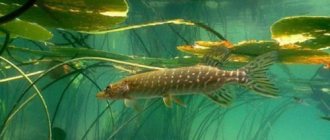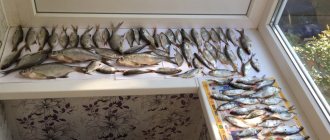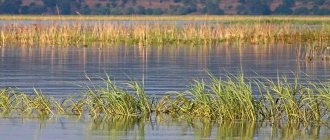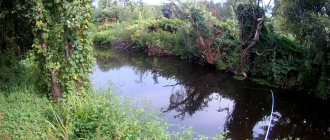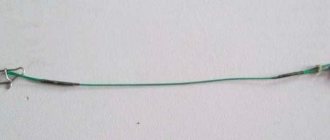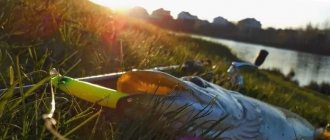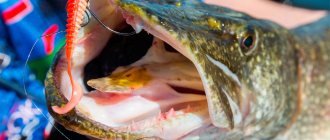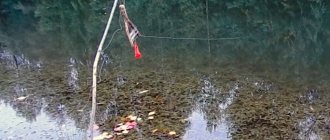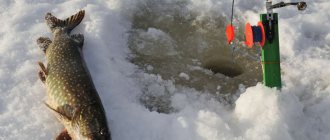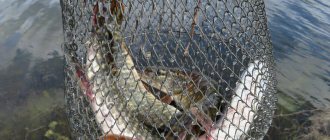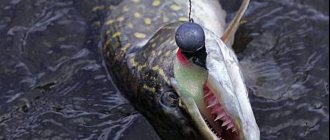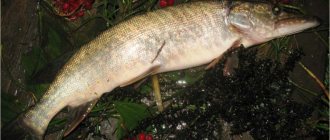The off-season this year was delayed - strong ice never appeared in our area - so I decided to continue spinning for pike. Just towards the middle of the first month of winter, another thaw came, and it became easier to do this.
Although at first, as always at this time, difficulties arose with the choice of reservoirs - so that not only could you go out onto the water without problems, but also hide from the wind. After all, comfort plays an important role in winter boat spinning. I just changed into a new winter suit, so I’ll test it in open water.
Pike instead of perch
As a result, the choice fell on one of the channel-type reservoirs, which has an elongated shape and is covered on both banks by a pine forest. And this is what you need in a damp, windy December!
We got out on the water by noon and started checking the spots where large perches live. Frequent hooks, a couple of torn baits and not a single bite - this is normal when hunting for “muzzles”.
The day is short, patience is not ironclad - we decide to switch to pike. This means larger baits and slightly different places - channel holes in the upper reaches of the reservoir, preferably with a concentration of white fish. And as soon as the fry was found, the predator showed up, leaving teeth marks on the 4-inch vibrating tail. In color 085, this is one of my main “scouts” for pike. And in general this color is good in clear cold water.
Let's go further, that is, upstream. The wind is twisting, preventing you from standing correctly, local holes appear first to the left, then to the right, and now you manage to find one of them - the pause on the “step” has noticeably increased. I just thought that soon there might be a brow writhing, a good stretch. I slightly released the clutch on the reel and took the predator into the landing net without any problems. They didn’t measure, they didn’t weigh, they took a photo, a short video, and let us go. “Treshka” offhand. Of course, I wanted to test and catch something new before the season was over, but the classic worked again - a big one in “green oil”.
Since the beginning of November, my main spinning rod has been Salmo 2. I used it, complete with a reel of the same name, on this fishing trip. I liked the sensitivity in the jig, good performance in fishing, and a comfortable handle.
Then I thought that on occasion I would need to try it with wobblers. But, as they say, not all at once. The next trip also turned out to be a jig.
Where is the best place to hunt a predator?
Pike on a spinning rod before ice freezes bite especially well in the following places:
- deep-water pits for wintering (away from the coastline);
- thickets of aquatic vegetation and accumulation of snags;
- holes at the confluence of several streams;
- areas around trees that have fallen into the water and holes that have appeared there;
- potholes at turns with snags;
- exits from bays to the riverbed;
- sudden changes in depth.
Due to the fact that the pike begins to eat before the freeze-up, there is an excellent opportunity to return home with a decent catch.
I usually go to Sazanya Bay, where I can catch a trophy specimen. But when I go fishing, I stock up on various rods and gear in advance in order to try out all possible tactics and fishing techniques. But I have already described my main recommendations above.
TAGS:
Twisters for pike in a village pond
The prolonged warming gradually began to free small bodies of water, which had no current at all, from ice. Having learned that the ice had melted on one of the village ponds that was interesting in the cold season, I headed there.
The grass has completely fallen off - you can set fire to places where this could not be done before. First of all, I traditionally check the holes along the bed of a small flooded river. But this December for some reason they are empty - it’s mid-autumn, and that’s all! However, the pike still reveals itself quite quickly - on hard water, sometimes with small gentle slopes of 30-40 cm.
News: Groundbait for striped fish
I also took a wobbler box with me, but again I pay most attention to the jig - I don’t know why, but even a passive pike in the off-season often reacts more willingly to the fast step-by-step retrieve of soft baits than to the slow animation of wobblers.
True, this time the predator is not always caught, sometimes leaving only scales on the hooks - it either misses or drives away. There were a lot of bites; at one anchor right next to the boat, the toothy one attacked the twister three times, but it never got detected. But it gradually becomes clear that bites occur on various worm-shaped baits with long tails. I had to climb through the bins and equip a small twister set. I tried to get larger, but this did not affect the size of the predator - on the contrary, even the perch “flew” into the voluminous Crusher.
Traditionally during the off-season, the ponds were filled with carp. We can say that the 6 kg mirror “hog” was caught by accident. Previously, sometimes it was possible to “calculate” the carp and even purposefully catch it, but now it was simply hanging on the second cast after a clear, as it seemed, pike bite.
Frost and sun. Fishing with a retractable leash before ice freezes.
Winter spinning in our region is very poorly developed, and the reason for this is not the lack of desire of local fishermen, but climatic conditions and the insignificant influence of industry. With the onset of cold weather, almost all bodies of water, with rare exceptions, are covered with a crust of ice, reaching a thickness of more than a meter by mid-winter. There are practically no rivers fed by warm runoff, which allows them not to freeze in cold weather, which is an environmental plus and a big minus for spinning.
November 18th. I can’t remember such a cold autumn. During the day, the thermometer consistently shows -10 degrees, but at night it hits the mark. Relatively mild frost, but in the complete absence of snow it is very sensitive. The icy wind penetrates under any clothing. Small and medium-sized rivers are already frozen. There are already more people on the ice than at an ice battle; the feeds of local fishermen on social networks are filled with photos from the ice and spinning rods packed for the winter. Unlike other bodies of water, the Volga has not yet given up, its expanses of water have not submitted to the frost. A violent temperament is not shackled by ice.
Having received several invitations to the opening of the winter ice season on Friday, I politely decline them. I’m in no hurry to get the drill and winter box, but go to the pharmacy for Johnson’s Baby baby oil and Vaseline ointment. My plans for tomorrow are completely different from other fishermen. In the evening I saturate the cord with oil and thickly lubricate the rings with ointment. The goal for tomorrow is spinning.
Saturday morning is not what the well-known Gismeteo service promised; instead of bright sun and wind of no more than one meter, dark clouds overloaded with precipitation hang over the river, a piercing wind blows, driving up a considerable leaden wave. The river struggles with all its might against the inevitable ice captivity.
It's cold, very cold. I tighten all the elastic bands, cuffs, and Velcro on the suit. The frost is fierce. There is no one on the shore. I spent the entire last season fishing on a lead leash with a Provokator 752L, which I was incredibly happy about, since I got into my hands exactly the type of rod that I had been looking for for several years. The realities of the upcoming fishing required a completely different set. The perch, moving away from the shore for maximum release, forced the use of heavier equipment, and the maximum diameter of the guide rings also became necessary as an indispensable element in case of high icing. In this connection, the choice fell on Kando 732ML. This model does not quite fit the mold of an ideal rod for a retractable leash, but there are no such large rings on any of my spinning rods in this test. With Kando I like to twitch wobblers and fish with unloaded rubber; I never considered it as a stick for a retractable leash. But, as they say, whatever is done is for the better.
The first place is the old city beach. Within the casting range there is a local hole six meters deep. Due to the rising water level, a maximum cast was needed to reach it. The weight on the rig was tied at 16 grams, the bait was a two-inch super slug from Keitech, and a leash made of thin Sunline fluor. The icy wind in the face and the first unsuccessful casts began to cool down all the fishing excitement. The goal of the fishing was to catch a couple of fish and quickly return home to hot tea and a soft sofa. I didn’t notice the first bite, I was retrieving automatically, looking at the surrounding gray late autumn landscapes. Surprisingly, the twitch stake, which I use to pluck pikes from snags without any embarrassment, worked for micro-perch. I was glad to see him, since all my thoughts were already connected with returning home.
After him, a larger brother came across. Both fish bit very greedily. The bait was in the depths of the mouth, which inspired further search for fish, rather than returning home.
There was no desire to stay here - the cold headwind, from which even a thick mask did not protect, left no chance of fishing in this place. In connection with this, I decided to move to another area with the expectation that the wind would blow at least to the side. In this area, the Volga makes a very sharp turn, so literally a couple of kilometers later, having moved to another section, I just settled in such a way that the wind began to blow not in my face. This point is a kind of sea breakwater, cutting ten meters into the water. Previously, there was a sauna on a pontoon, which subsequently caught fire and sank almost like in a film with DiCaprio, turning into a large “fish house”. Near it there is a rather sharp drop-off, a place that is extremely popular with local fishermen in the summer and empty when cold weather sets in.
Here, besides me, life glimmered in the form of two feeders and a whole pack of carousers. Small homeless dogs with sad eyes surrounded me in a heap, but I had nothing with me to eat.
The first cast was without much enthusiasm. I start playing with a small bait at the bottom, characteristic chewing, hooking, and something solid ends up on the hook. Tense fishing, and an excellent humpback fish in my hands. “What a turn!” was the first thought that flashed through my head. A quick photo shoot in which the fish turns to stone from the frost and wind, I release it back. I make a second cast, blow up, fall on the spot, blow up again, hit, and another handsome guy ends up in my hands. I begin to notice that it turns out that it’s not so cold outside, my petrified fingers again began to easily adjust the bait on the offset machine, and it became a little hot in the hood. Then it began like in a fairy tale - on absolutely every cast I came across a perch, the size was rated from nano to large humpback whales. While fishing, I felt like some kind of savior: the caught fish were either eaten by cuties, or passed to two seagulls, who until that moment had been screaming forlornly over the water surface. By lunchtime, the weather forecasters' predictions began to come true a little. The wind dispersed the clouds, the bright sun flooded the entire neighborhood. The bite did not subside even for a second, the tip of the spinning rod perfectly informed about all fish contacts, earning respect in this fishing technique.
It was already past lunchtime, but the bite, like a machine gun, did not die down for a second. Having had my fill of perch bites, I begin to experiment, trying to cut off small things with larger baits and selectively get humpback whales, but this gives absolutely no result - the strikes stop completely, but as soon as I return the two-inch fry back to its place, a new wave of greedy bites surges with greater force. After half an hour, this kind of Eldorado and the lack of any results from the experiments begin to get boring, and I’m going home. The last fishing gave me great pleasure, several useful observations and a good hundred perches. The cubs on the shore no longer squealed pitifully, but lay down with full bellies under the concrete slab, and the gorged seagulls stopped screaming sadly, hovering over the lead water.
For several years of pre-winter spinning just before the freeze-up, I have never encountered such an active perch bite that was not embarrassed by high pressure, temperature changes, and constant changes in wind strength and direction. On this day, all the fish had the bait deep in their mouths, despite the fact that I didn’t let them “chew” it for particularly long. It was not possible to understand what caused such active biting. Communicating in the evening with comrades who sat on the ice literally a couple of kilometers from here and were content with a couple of dozen medium-sized perches during the entire daylight hours, we were unable to establish a cause-and-effect relationship between them and my result, and this, in principle, is not important, the main thing is that it was a great time a day doing what you love.
Share
Search for pike and hard bottom
By the middle of the month I thought that there was no ice anywhere, but upon arrival at the next body of water, a surprise awaited me - the swans did not swim on it, but walked on it. Fortunately, there was plenty of open water, but on the other side. Therefore, not immediately, but we came to this very water!
By this time, on all reservoirs, the grass, which was rampant in the summer, had settled, and it was possible to fish with any bait without any problems. Immediately we encountered some kind of anomaly - almost every wiring ended with a bunch of “green stuff”, even on non-hooking ones.
From the box with wobblers I took the shallowest version of the available baits in the floating version. With her I left “zero”. One of my favorite colorways, number 704, worked.
Thus, I caught a spinning rod based on the wobbler theme, although the Antira’s retrieve was not jerky, but rather “stop-and-go” and in the usual uniform manner.
Wobblers also often caught grass, so the search for a hard and clean bottom continued, moving up the reservoir - to the mouth of the inflowing river.
On the way to the upper reaches of the reservoir there were bites for rubber. Sometimes they are very angry, but they never succeeded in realizing a single one - either the tail will bite off, or it will simply hit or go away.
However, this is a familiar picture for this December. I was already tired of dealing with this problem, so we just enjoyed the process. The sun and calm contributed to this in every possible way.
The bottom gradually became suitable for comfortable jig fishing, and after lunch a clear exit appeared - there could be up to five bites in one hole. The implementation, however, has the same problem, but we managed to catch something.
At first, Crusher and Mr. got the most bites. Greedy in brown S07, but in the evening Spark Tail 4 took the lead - its implementation was better. The color S13 stood out in particular.
